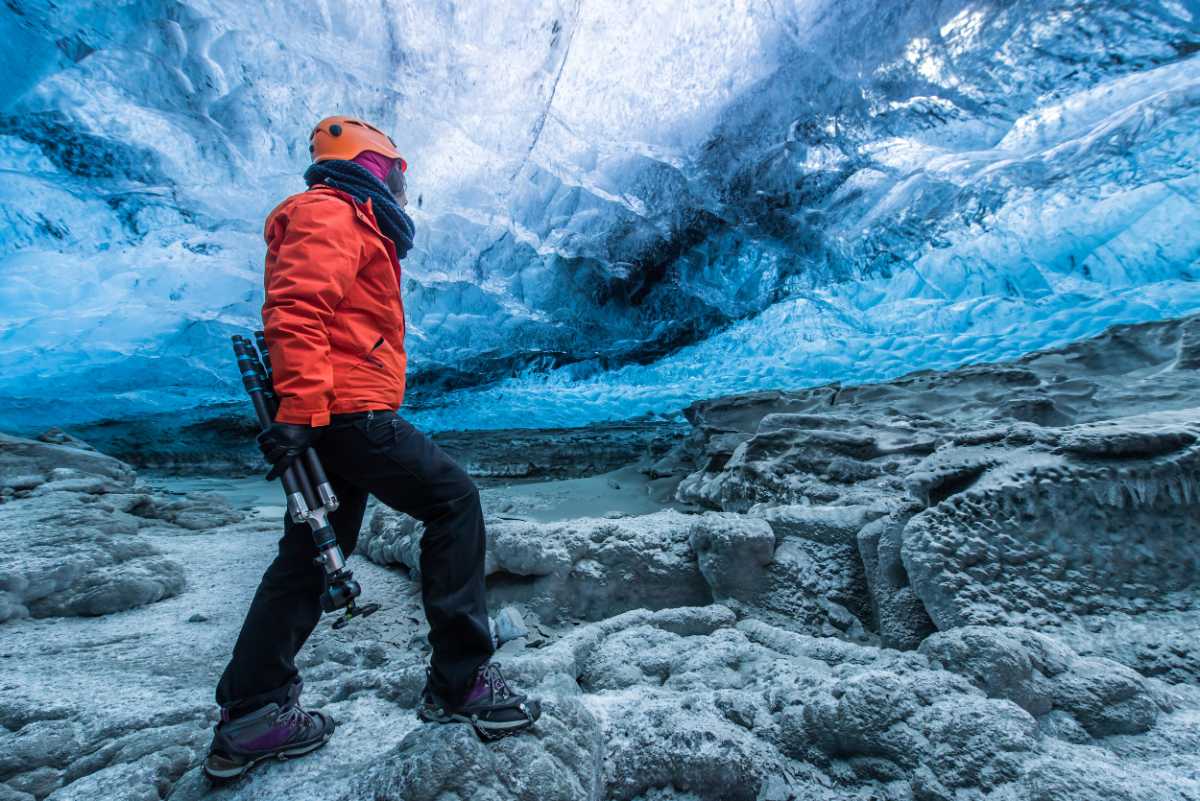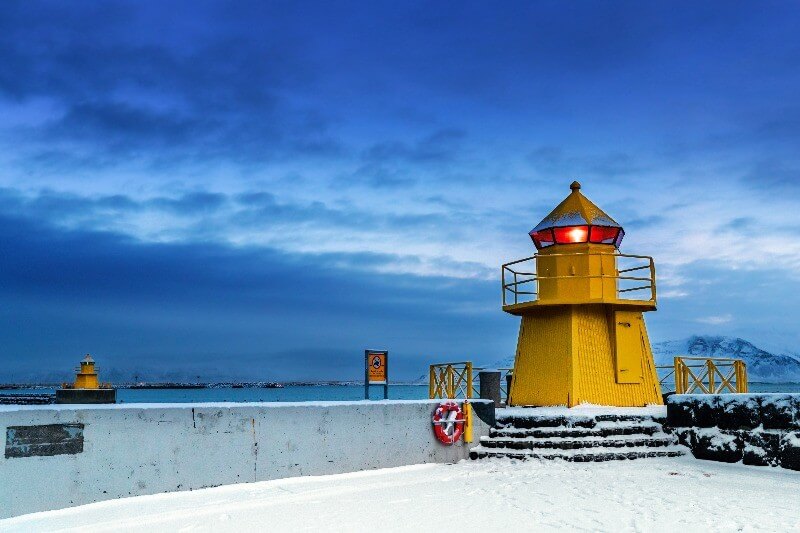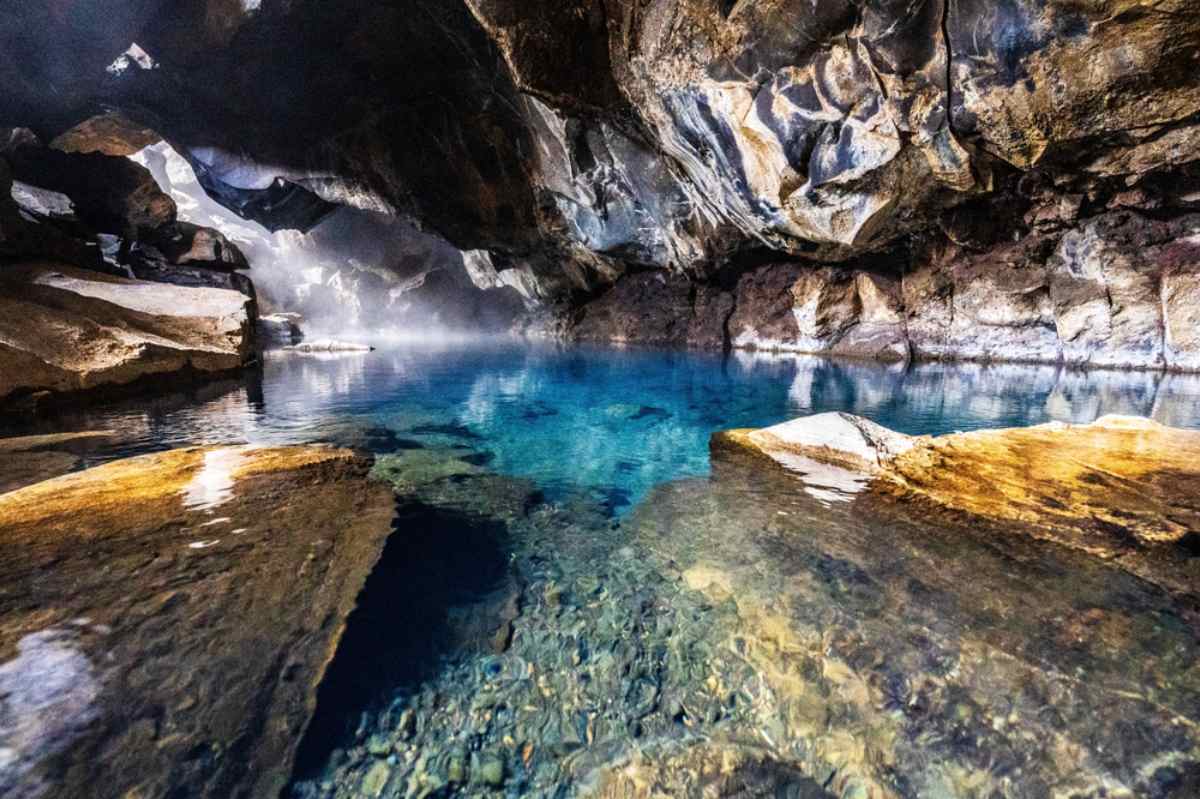Iceland is known for its breathtaking landscape, but have you ever seen the wonders waiting underneath its surface? Gjabakkahellir Cave is one of Iceland’s geological wonders, where you will get a completely new perspective on what it really means to be the Land of Fire and Ice.
In this article, we do a deep dive into the cave and the type of immersive (literally!) experiences one can have there. We also give you all the essential info and insights to plan your visit to this extraordinary place. So, let’s get started!
What is Gjabakkahellir? A Short Overview
Gjabakkahellir is a 9000-year-old lava cave that stretches out for 360 meters and has the unique feature of having openings at both ends, allowing people to walk straight through. It’s also one of the few caves in Iceland where one can go on a solo exploration without a professional guide leading the way.
The name Gjabakkahellir translates to "Cave of the Edge of the Ravine," but is commonly referred to as “Little Girl Cave”, and no one really knows why. The cave was discovered in 1907 when workers were busy building a road between Thingvellir National Park and Geysir (the OG of geysers everywhere) per instruction of the King of Denmark.
View this post on Instagram
The Geology of Gjabakkahellir: How the Cave was Formed
The reason why Gjabakkahellir is referred to as a lava cave is because of how it was formed. Gjabakkahellir Cave truly started with a bang all those thousands of years ago, as a volcanic eruption occurred. Instead of the lava flowing across the landscape, it came gushing down in a river. This river typically consists of basaltic lava, which in Iceland is primarily of the pāhoehoe or ‘a‘ā varieties.
The icy surroundings and cold air immediately started to cool down the outer layer of this river, causing it to harden and form something that resembles a tunnel. Yet, the inner part remained hot and liquid and eventually flowed out of the newly formed tunnel and into the surrounding landscape (hence the lava fields). This is why lava caves are often not what you envision a cave to be.
Most conjure images of dark caverns in the rock face of a mountain cliff. But lava caves usually look like random gigantic holes in the ground since these underground tunnels are mostly discovered when time or some geological event causes the roof of the cave to, well, cave in somewhere. This would then usually serve as both the entrance and exit to the cave, which is why Gjabakkahellir, with its openings at both ends, is so special.
View this post on Instagram
The Wonders that Await Inside Gjabakkahellir
As you can imagine, anything created by a powerful volcanic eruption can have all sorts of interesting attributes. This is definitely the case when you see the wonders that await you inside Gjabakkahellir.
You’ll get to see all sorts of interesting rock and lava formations, stalactites hanging from the roof of the cave, and stalagmites reaching up to them from the ground. The tunnel walls, with their myriad of colors, are also a testament to the different minerals that came along with the lava from deep within the earth.
Where is Gjabakkahellir in Iceland?
Gjabakkahellir Cave’s location makes it one of the most convenient attractions to visit here in Iceland. It is one of the natural wonders found inside Thingvellir National Park in the south of Iceland, just over an hour’s drive from the capital city of Reykjavik and one of the very first stops on the Golden Circle road trip route.
How to Get to Gjabakkahellir Cave
You will essentially have two options when it comes to visiting Gjabakkahellir Cave:
Visiting Via a Guided Tour
Many tour operators and local guides offer tours to Gjabakkahellir. The cave can form part of a multi-day holiday tour or a combination day tour or be the sole day tour destination. Most of these tours will depart from Reykjavik. If you go on a tour that also explores the inside of the cave, you will be provided with all the necessary gear and equipment. A tour inside the cave tends to take anything from 1.5 to 2 hours. A few popular tour options are:
- Gjabakkahellir Cave Tour (departing from The Cave People, Laugarvatnshellar)
- Golden Circle & Lava Cave Tour (departing from your accommodation in Reykjavik)
- Customized Tour by Travel Local
Visiting Via a Self-drive
Whether you decide to make Gjabakkahellir a day outing or a stop along your Golden Circle road trip, or you need to meet up with your tour there, the best way will always be to simply drive yourself. That way, you’re always in complete control and can truly immerse yourself in the Icelandic nature. A self-drive to Gjabakkahellir is quick and easy:
- Take the Ring Road north from Reykjavik.
- Continue on this route for about 17 kilometers (10.5 miles).
- Drive onto Road 36 close to Mosfellsbær.
- Drive through Mosfellsær till you reach the traffic circle.
- Take the first exit to continue on Road 36.
- Follow the signs to Thingvellir National Park.
- Once inside the park, simply follow the signs/directions to Gjabakkahellir.
- Once you’ve parked your car in the cave’s parking lot, it’s just a short 10-minute walk to the entrance of the cave.
View this post on Instagram
When is the Best Time to Visit Gjabakkahellir Cave in Iceland?
You can visit Gjabakkahellir all throughout the year, and since you don’t need to book a spot on a tour to explore this natural wonder, you’re not even bound to specific times. That being said, there are a few things to take into consideration when you’re busy planning your Gjabakkahellir Cave trip:
- Many prefer visiting during the summer months (June to August) because the weather is at its best here in Iceland, and you’ll have plenty of daylight hours (perfect for jam-packed itineraries filled with outdoor adventures).
- During the colder months, you’ll need to check whether you can even reach Gjabakkahellir in the first place. This is because the cave is known to become unreachable due to snow (making road conditions challenging and blocking entry). Also, short daylight hours can limit your exploration window.
- Others absolutely swear by visiting during the winter season here in Iceland. That’s because this is the only time you’ll find the most incredible ice “sculptures” inside the cave, turning it into a real winter wonderland.
- If you’re trying to avoid our peak season crowds (and prices), try to visit during our shoulder season months (March to May and September to October). You’ll still get many of our weather and daylight perks but without most of the peak season drawbacks.
View this post on Instagram
What to Pack for Your Visit to Gjabakkahellir Cave
Since this is a cave that you are allowed to explore on your own, there are quite a number of extra essentials you’ll need to remember, which would otherwise have been provided by a tour operator. We’ve created this nifty packing list for you to ensure that your visit to Gjabakkahellir Cave is a memorable one (and for all the right reasons!). So, when visiting the cave, ensure that you have the following:
- Layers of clothes, starting with thermal underwear and some pretty thick jackets. This way, you’ll always be able to put something on or take something off, ensuring you’re ready for any situation (especially during the warmer months, where the outside will be much warmer than the cold cave).
- Sturdy, waterproof hiking boots. The cave can be wet and slippery at times, so you’ll need something that will keep your feet both dry and warm, as well as have a good grip.
- A flashlight (preferably a headlight to keep your hands free) to explore the deep, dark depths of the cave.
- A helmet. This may seem excessive, and you may feel silly, but this is an absolute essential that tour operators usually provide. Not only will this protect your head if you should ever slip and fall, but it will also protect you against low ceilings in some parts and potential objects falling down from the cave roof (this can be anything, from a stalactite that breaks off, little pebbles, ice, you name it). It’s better to look a little silly and be safe than sorry.
- A first-aid kit. Once again, this is just to ensure you are prepared for the unexpected. In medical emergencies, what you do in those first few minutes can be the difference between life and death.
- A warm hat (woolen beanies are perfect and can easily be worn underneath a helmet), warm woolen socks, and gloves. You really shouldn’t underestimate the cold of the cave so deep below the surface of the ground.
- Elbow and knee pads (optional). This is once again to up the level of safety for if you should slip and fall. It will also protect your knees and elbows if you’re someone who already foreshadows crawling somewhere in the cavern (for example, elbow pads are very helpful items to photographers trying to capture all sorts of interesting angles).
View this post on Instagram
Other Things to See and Do Near Gjabakkahellir
Given its location in Þingvellir National Park, Gjabakkahellir is an ideal stop on your Golden Circle itinerary! If you’d like to extend your exploration of the surrounding area, the following attractions come highly recommended:
- Silfra Fissure
- Öxarárfoss Waterfall
- Almannagjá Gorge
- Geysir
- Thingvallakirkja Church
- Gullfoss Waterfall
Gjabakkahellir: The Ultimate Geological Adventure
Whether you make Gjabakkahellir Cave a day outing from the capital city or a stop along your Golden Circle road trip, you’ll be walking away with lifelong memories of a once-in-a-lifetime experience.
Interesting lava and rock formations, rich mineral colors lining the cave walls, and much more make this the perfect adventure for the curious traveler and explorer. So, what are you waiting for?! Book your flight and rent a car in Iceland - adventure lies waiting right underneath the surface (literally)!


 By
By


